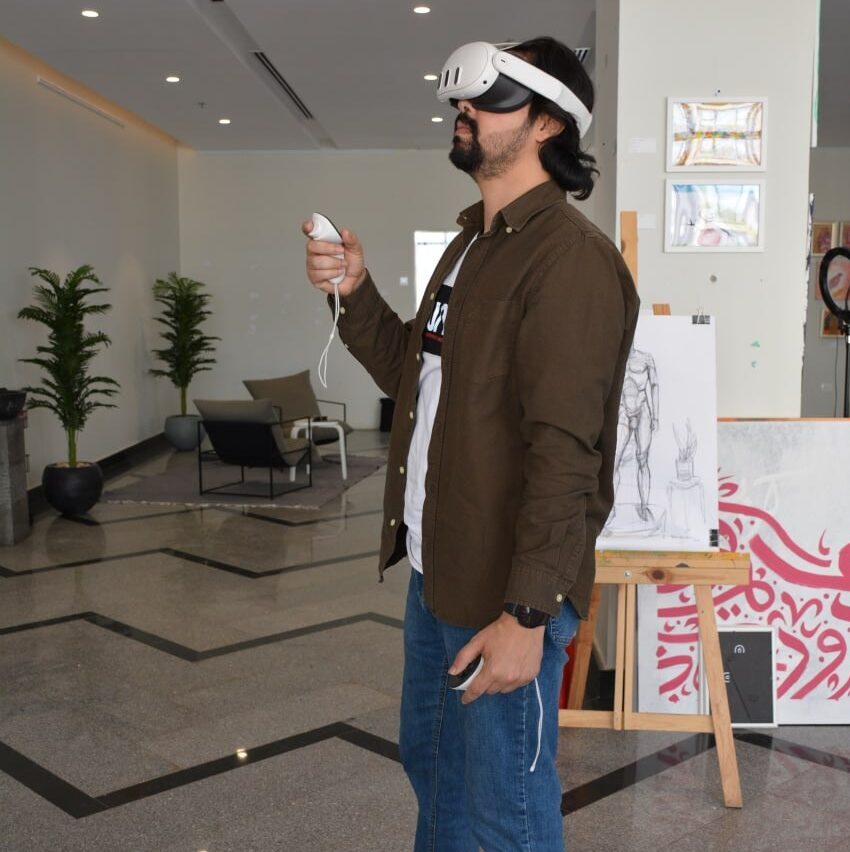He want to connect two worlds: the real and the virtual, the past and the present… Ahmed Abdel Fattah is a contemporary Egyptian painter and one of the first artists to work with virtual reality in Egypt, using and integrating it as an artistic medium. His works have been exhibited internationally and he has won several awards. He uses the psychology of visual objects in his work, focusing on experimentation and creating color rhythms within a realistic setting. We met in real life in a corner of Cairo to discuss his work.
Ahmed Abdel Fattah: My name is Ahmed Abdel Fattah. I am originally a painter and VR Artist and now doing art with technology. I am an assistant teacher of fine arts and I am currently completing my PhD in the field of virtual reality at Luxor University.
Emmy: When did you choose to be an artist, or did art choose you?
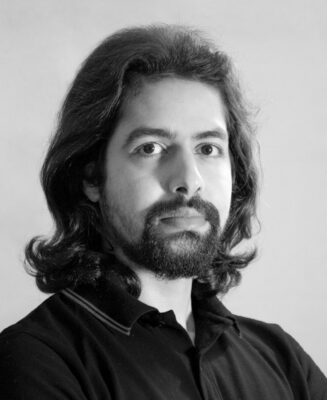
Portrait of the artist
A. A. F.: Both! I discovered art when I was around 4 years old. My father can paint, write poetry, sing, and do many things, but he never worked in any of this, I’ve never seen him paint. I used to watch cartoons on TV and paint them on my bedroom walls, along with my elder brother. My dad did something unusual: he encouraged me to continue instead of telling me off! He got me the paint and tools I needed to draw, and I started to be known and liked at school for drawing people. This was when I found what I wanted to do. He guided me in my studies, until I entered the artistic field and established myself as an artist.
E.: What do you like to paint: people, nature, or buildings?
A. A. F.: I work on the psychology of visual elements in general. I do not like to limit myself because nature and the environment that surrounds me are many things. I love things that touch me in some way and draw my attention. In my opinion, the role of art is to notice of the fine details that people do not see. The artist is used to observing things and can benefit from the power of their practice. I want to highlight aspects of simple things in life that may often be overlooked.
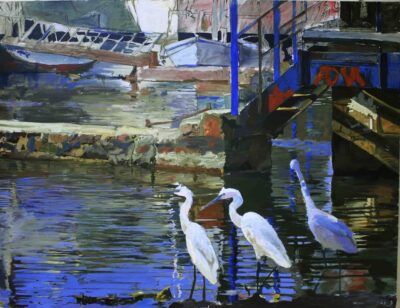
Oil on canvas – 2011
E.: Do you paint with “real colours” or the imaginary ones you see?
A. A. F.: I am trying to link both. I feel like my work is contemporary and realistic, in between impressionism and realism. I sometimes use colors that do not actually exist, that are slightly exaggerated, take a little freedom. At the end of the day, the painting will look realistic.
E.: Let’s talk about one of the reasons why I wanted to interview you: your innovative and creative approach in virtual reality. How did it all start?
A. A. F.: I’ve loved technology for as long as I remember. I think the artist should be connected to these new tools. In the beginning I used to work with oil painting, which at a certain time was itself a new technology! I came across virtual reality in 2016, with Oculus, and then when I saw Google’s Tilt Brush software demo, where artists were the headset, use digital tools and paint in the air, I thought “this is the future!”. It combined everything art-related: performance, art, music. The audience can enter the artist’s world wearing glasses and be part of the work.
E.: I feel like virtual art has a limited lifetime, which is its production time, then it can’t be seen in reality. How can it survive?
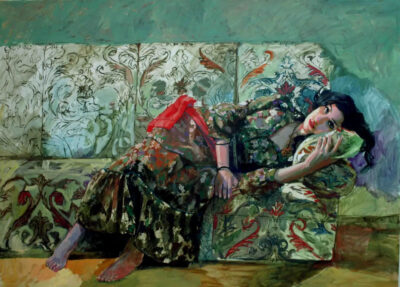
Oil on canvas – 2024
A. A. F.: Virtual reality art goes through several stages before it’s exhibited. I work on more than one software. I don’t think real and virtual art compete with each other, as they have a different target. Real life is actually much more advanced than any device or any technology we’ll ever come up with. With virtual reality, we can achieve things we did not know we could: we can fly, change the way we look every day, create avatars, go beyond our physical limitations. There are many projects right now where artists meet and work together live in virtual reality, and combine it with augmented reality and real artistic work.
E.: Coming back to the real world, one of the most important concepts in your work is “the tree”. What does it mean to you?
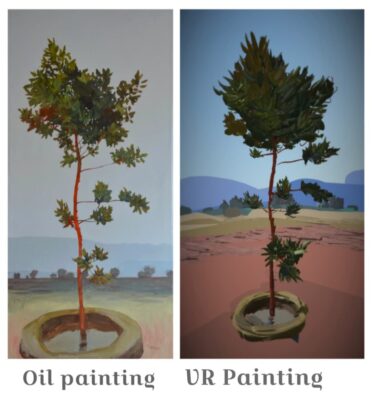
The tree – 2021
A. A. F.: I work on both the concepts of the human being and the tree. They are linked to each other in the sense that they are small, deal with different life circumstances or seasons, facing wind, rain and storms. They change and grow. I found out that trees are important in all religions and cultures, even in Ancient Egypt! They were convinced that trees were the image of God on earth and used to paint some gods in the forms of a tree. Isis and Nut, for instance, were painted in the form of a tree. There is the concept of the holy tree in some cultures, and the story of Moses, which can be found in three religions. In Islam, God revealed his light in the oil of an olive tree located in a specific place. So the tree links many things between earth and heaven, and the holy. The first project I did for Tam Gallery was called “The First Tree in the Metaverse”. I liked that my first work was a tree because it was also the first thing that existed in life.
E.: Another concept present in your work is Egyptian mythology, drawn in virtual reality. Tell us about the story of Isis and Osiris.
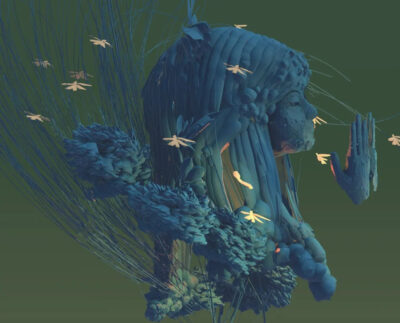
Isis – 2023
A. A. F.: Originally, my work was not connected to ancient Egyptian civilisation, even though I studied it and my work is currently in Luxor, one of the cities where you’ll find the biggest number of ancient Egyptian monuments. I did not see how I would be able to represent this ancient art differently, because for me it was at the top of everything that was done at the time. When virtual reality came out, I felt that I could set myself free from strict representation and started getting inspired by them such as the story of Isis and Osiris. I liked the wooden statue of Isis where she calls on to her husband and brother Osiris after he was killed. She collects the pieces of his body to bring him back to life again. They then have a son, Horus, this is a well-known story
E.: Where do you get inspiration from?
A. A. F.: Mostly, I walk. Places and what I find in them have a big influence on me.
E.: Which artists do you like?
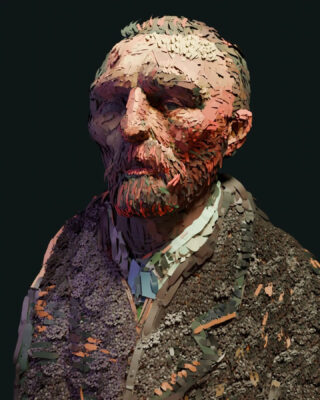
Van Gogh – 2024
A. A. F.: I love many artists, some for their style, some for the way they think. When I was young, I liked Leonardo da Vinci, he’s an artist who did many things. I never used to like Michelangelo’s work, but I did like the way he connected thought and art to create something new, with no fear. This is real art! Picasso proved this point: he was bold, and had the ability to change his style more than once. He became one the most successful artists of his generation and in history. By the way, he is considered the first person who ever created virtual art, by painting in the air! He had a friend, Gjon Mili, who took a famous picture of ballet dancers while performing, with specific shutter, and the lights they move with look like a painting. Picasso liked the idea and started painting with a lamp in the air while the camera recorded the image. This is the same idea as virtual reality. I also like Lucian Freud, Egon Schiele and Gustav Klimt. As Egyptian artists I like Mahmoud Mokhtar, Mahmoud Said and Seif Wanly.
E.: What are you working on right now?
A. A. F.: Many things! Through virtual reality, I was able to achieve something I didn’t know how to do for a long time, which is sculpture. It was just too complex to produce in real life, it takes preparation, and many tools. In the virtual world, sculpture is closer to reality. I make a virtual copy, and I paint it, linking both disciplines.
E.: What resource would you recommend to people who read us?
A. A. F.: As we’re talking about virtual reality, I’d like to recommend the “Museum of Other Realities” that I loved as soon as I came upon it. It is a whole museum that does not exist in reality. It’s available on Oculus, Five Pro, and Steam games.
E.: One last thing?
A. A. F.: I want to stress that artist needs boldness and should not be tied to business, or try to imitate other people. The artist needs to experiment with technology, see the developments that are happening and use them.
This interview has been edited for length and clarity. FIND OUT MORE Instagram: @ahmed.abdelfattah_ The artist at work at the Grand Egyptian Museum.
Podcast episode available on Spotify, Anghami, Apple Podcasts. Thank you to @artempowers_ for hosting me. All pictures © Ahmed Abdel Fattah

